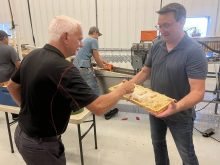The gaps in rural women’s health care are not just in the services, but also in policy makers’ awareness of what farm families want and need.
That’s why the federal government’s status of women department is paying $70,000 to researchers to find out more from women in rural and remote areas.
The isolation of those families is familiar to lead researcher Ivy Lynn Bourgeault. Now working at McMaster University in Hamilton, Ont., she was raised on farms in Saskatchewan and Alberta.
Bourgeault said the information gathered last year from about 30 focus groups formed the basis for an initial report. But there were missing areas, both geographic and demographic. Quebec and the far north had no representation and there were few participants younger than 35.
Read Also

Understand limitation periods if considering civil suit
A limitation period refers to the amount of time a plaintiff has to commence a formal claim in court or lose their ability to pursue it.
“So there is very little on maternity care and child care,” Bourgeault said.
“Issues like when the local ultra sound lab closes and you’ve drunk seven glasses of water and have to drive an extra hour are salient.”
She also wanted to hear more from Hutterites, women of colour and aboriginals who live on reserves.
The study team decided to broaden its collection by allowing individual women to complete a survey by computer or phone. To get to the on-line survey website, visit www.producer.com and click on links in the news. The survey’s 24 hour, toll-free phone number is 888-818-9172, extension 18. The survey ends in December.
All information will be kept confidential and processed into a final report that will be made available by the end of March.
Bourgeault said rural women are defined as those living in towns with less than 10,000 people or more than an hour away from medical specialists or major hospitals.
While some farmers were interviewed in Alberta and Saskatchewan this summer, she said it happened before the heat withered crops and when the beef industry crisis was still new. She suspects she might hear more about farm stress if women are surveyed this fall when the bills come due.
She is also hoping the more private surveys will draw out stories of domestic violence, since that is a topic unlikely to be volunteered in a focus group “because these are the people you grocery shop with.”
Bourgeault said the results to date have found the top three issues for rural women to be the decline in access to health services, the impression that health professionals stereotype rural women as not too bright, and the need for more female health-care providers.
“One thing we heard a lot about is the lack of sensitivity to the difficulty of getting to services. You take time off work, drive for three hours and get five minutes of the specialist’s time.
“That’s in essence a two-tiered system. You don’t have to pay for the care but you have to pay to get there or stay there.”
Lil Sabiston, a farmer from Kelliher, Sask., is happy with the draft report based on last year’s process. She is on the survey’s national steering committee, representing the Prairie Women’s Health Centre of Excellence.
“A great deal of work was done to develop it. I hope that government will pay attention to what women want,” Sabistan said.
The draft report has 27 recommendations for making health policy work better for rural women. Besides the issues raised by Bourgeault, rural women want:
- More money given to local and grassroots groups so they can involve people in consultations and decisions.
- Government policies that ease the stress of women’s multiple roles, such as flexible work hours, benefits for part-time workers, wage equity, affordable child care and tax equity for women at home with children.
- More ways of spreading health information, such as websites and telephones, and making it available in more community locations, such as libraries.
- Stepped-up efforts to recruit and keep doctors, therapists, nurses and other health-care workers.
- More services made mobile.
- More health promotion and disease prevention campaigns.
















